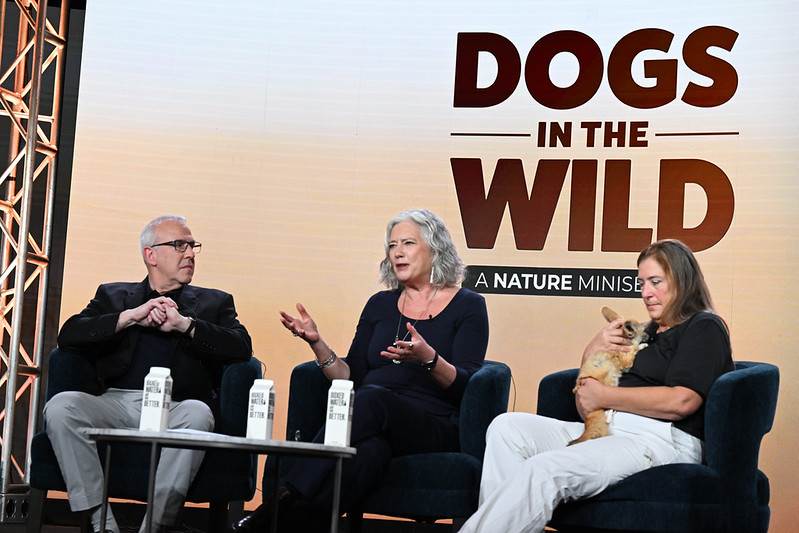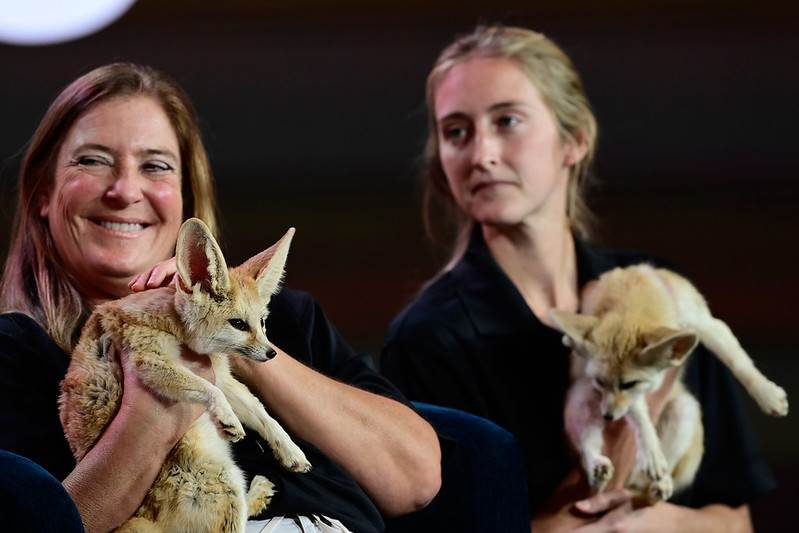“We've done cats, primates, sharks, and it's a real privilege to get really detailed in that, and showcase animals that I think a lot of people wouldn't have even heard of,” BBC Natural History Unit Executive Producer Jo Shinner said during a TCA press conference for the new PBS Nature three-part series, Dogs in the Wild. Like Super Cats and Primates, the miniseries shines a spotlight on the 37 species of wild canid, many of which viewers have likely never heard of before. “A third of this species are threatened. The red wolf in America is the most critically endangered out of all the canid species. There are 20 individuals living in the wild. And then in Ethiopia, the Ethiopian wolf, which is being pushed higher and higher and higher up into the plateaus there, there are 500 in the wild. This is very difficult to sustain.”
Broken into three parts, the first two will highlight the diversity of the canid species while the third part will showcase the work being done to ensure their survival to maintain Earth’s delicate ecosystem. “There's amazing conservationists in America who are doing this thing called cross-fostering with the red wolf,” Jo Shinner explained. “They take the newborn pups from wolves in captivity, and put them in the dens of wild red wolves, who instinctively accept them as their own. And it's absolutely fascinating, but really important work. So as long as they don’t get shot when they go out, then they have a real chance of very, very, very slowly being rehabilitated back into the wild.”
Joining the panel was an animal ambassador, a fennec fox named Fig (and a playmate named Fenix). “This is the smallest canid on the planet,” Jo shared. “It's only like 20 centimeters high or something like that. And it's supremely adaptive to the Sahara Desert. It's one of the toughest, most formidable dogs that we have. I mean it's really, really extraordinary… We were there for weeks and literally impossible to film because they can hear you coming, smell you coming. They're really fast. They scamper across the dunes. They've got specially-adapted paws with long hair on them so that they can have traction on the sand. They are the same color as the sand. They're about four million years old and they arrived with the arrival of the deserts. So, they've had plenty of time to adapt to these really crazy sort of 40-degree conditions. And they're the only dog that doesn’t need to drink. They've got specially adapted kidneys, and they don't usually urinate that much as opposed to other dogs. I mean, they've just got superpowers.”
With their chihuahua-like size, their adorable faces, and their big ears, fennec foxes are regularly put in danger by humans who want to interact with them, which is highlighted in the series. “These animals may be trained, but they're not tame,” explained Jackie Navarro, Fig and Fenix’s handler from an organization called Wild Wonders which works with education animals, both of whom were born in captivity. “They never have been nor will they ever be pets. What you haven't seen with this little guy is his possessiveness over objects, willingness to bite, scent mark. These guys are not pets in any way, shape, or form, and we don't treat them as such. He may look cute and cuddly right now because this guy's an ambassador animal. He's used to being worked with programs. We do school programs all over, but he has never lost any of his wild instincts. So, yes, they're very quick to bite to defend themselves. They're very quick to be possessive over objects… We are all trained zoological professionals that work at our center, and these guys were captive-born and slated to be four-legged fur teachers. So that is their job, but they haven't lost their wild instinct in any way.”
“We did invent this little roving remote camera that we called a dachshund, like a sausage dog, and it had caster wheels so it could cope with the sand,” Jo Shinner revealed about new technology employed on Dogs in the Wild to help film the elusive fennec fox in the wild. “It was very, very low and could cope with low light because really our best chance was in dusk, sort of the half-light when they start coming out. That was a completely constructed and invented thing, and it was our only way of getting anywhere near the den without disturbing the animals. I mean, it’s one thing trying to get the shot, but also you don’t want to disrupt their lives either.”
Whether you’re tuning into PBS Nature to learn about biodiversity and conservation, or merely because you want to see some adorable animals, Dogs in the Wild has a lot to offer. “What was so fun making this series is that they are so very different,” Jo Shinner concluded about the 37 species of wild canid. “[Fennec fox] is the smallest. The tallest is the maned wolf in Brazil that looks like it's standing on stilts. It's got these really, really long, skinny legs so they can see over the grasses of the Cerrado. You have amazing black-backed jackals in the Kalahari who chase birds and doves, and you can see them flying in the air as if they were a bird themselves to catch their prey. There's an incredible variety of species. But what is really interesting about Canids in general is they're incredibly intelligent. They're incredibly resilient, adaptable. They're on all continents throughout the world except for Antarctica. They manage to sustain ridiculous conditions like Fig's wild cousins. And they are largely monogamous and they usually live in families. And that gives them this incredible sociability, which gives them strength. They hunt very often cooperatively. As anyone who has a dog knows, those are the features that you would recognize as well.”
PBS Nature presents Dogs in the Wild, premiering Wednesday, February 8th, at 8/7c on PBS. Episode will be available to stream later on PBS Passport.


